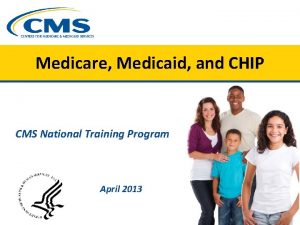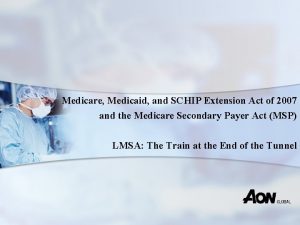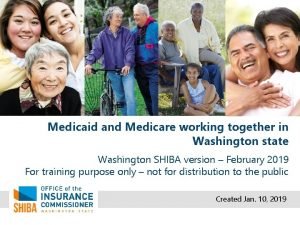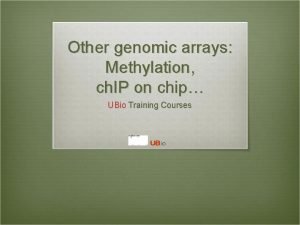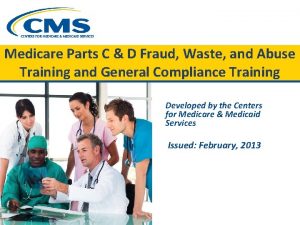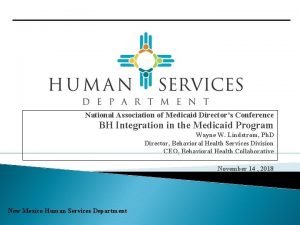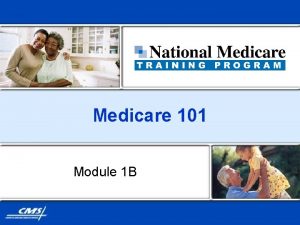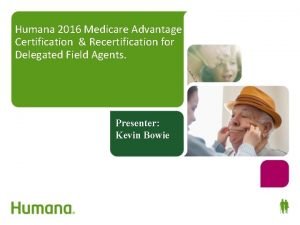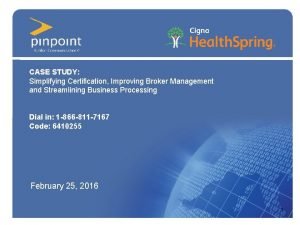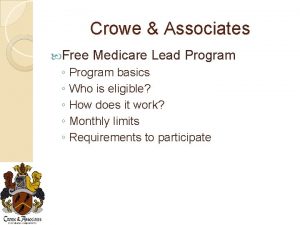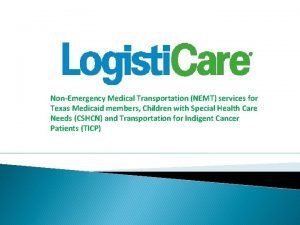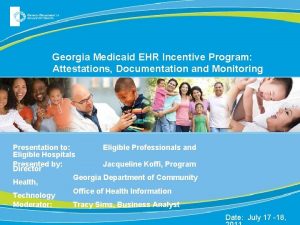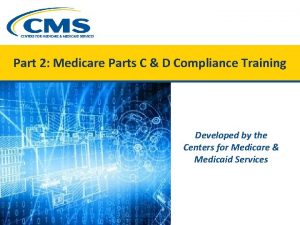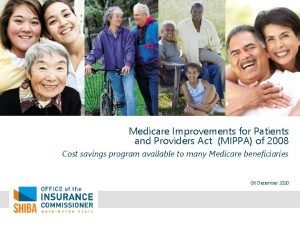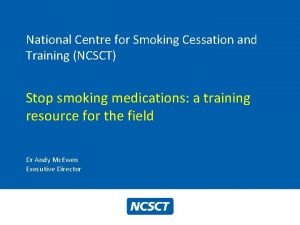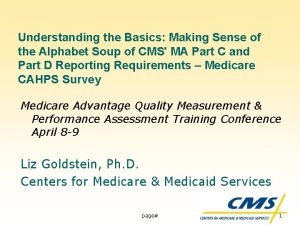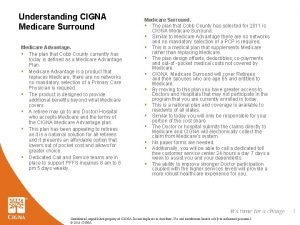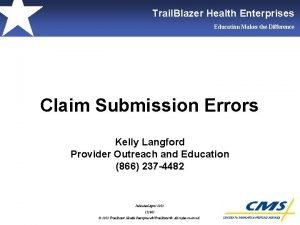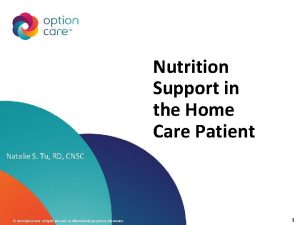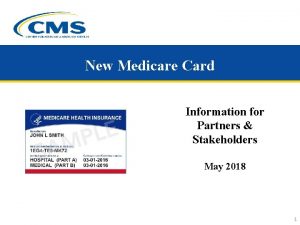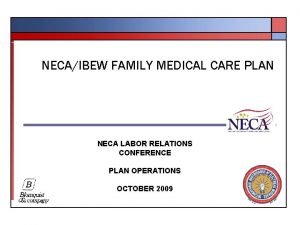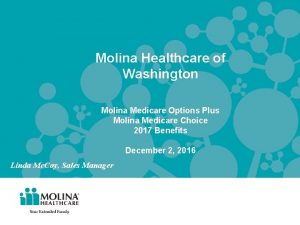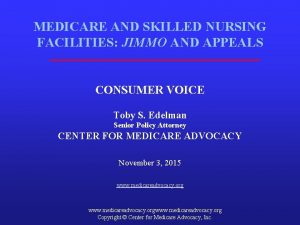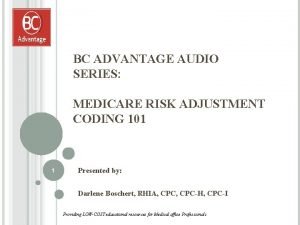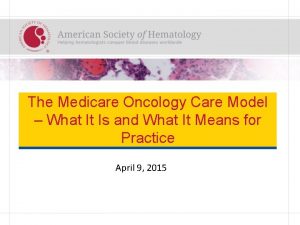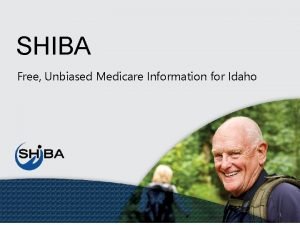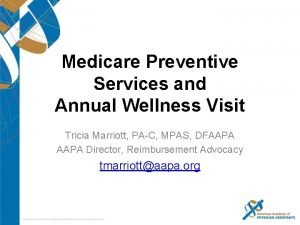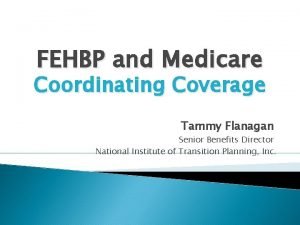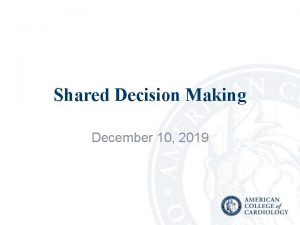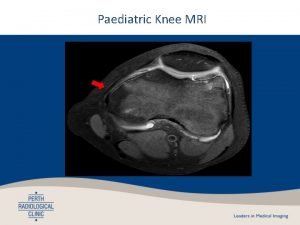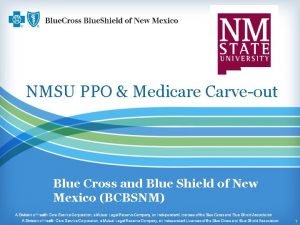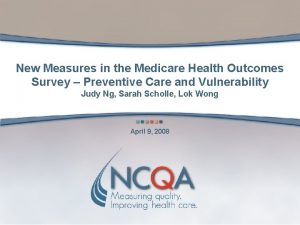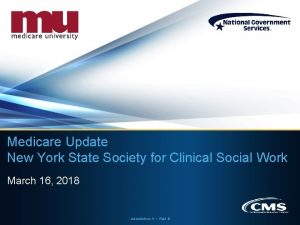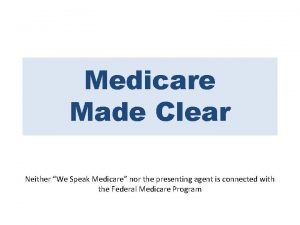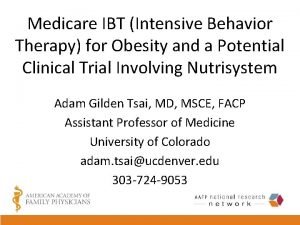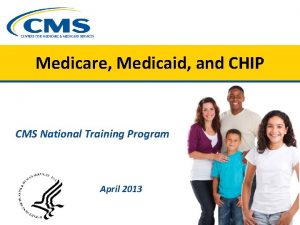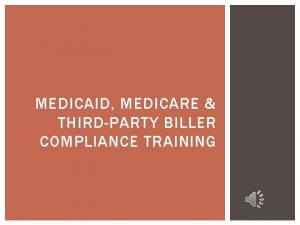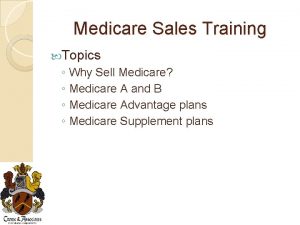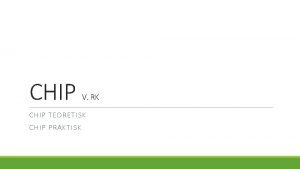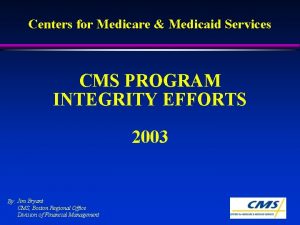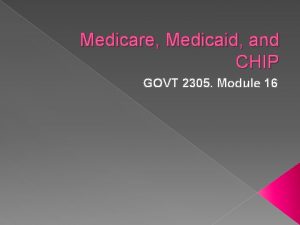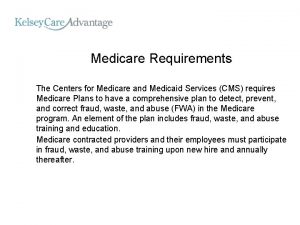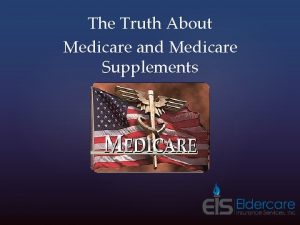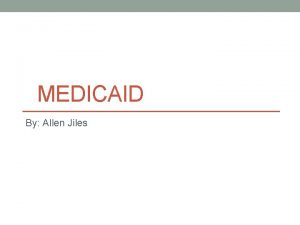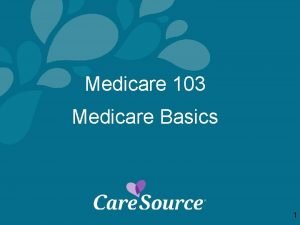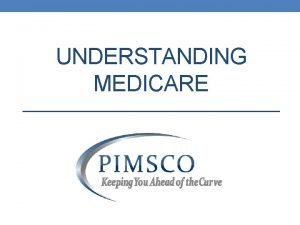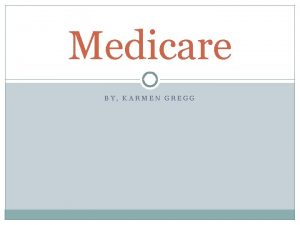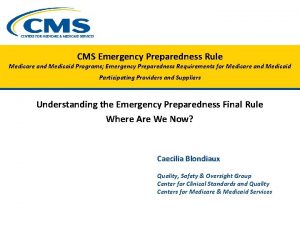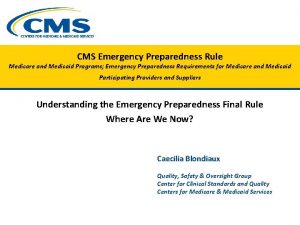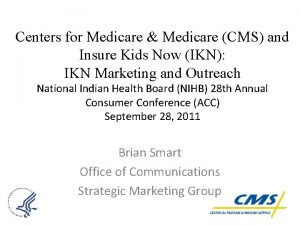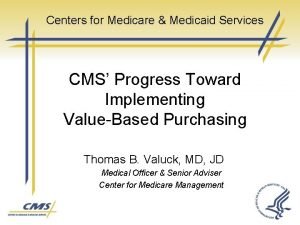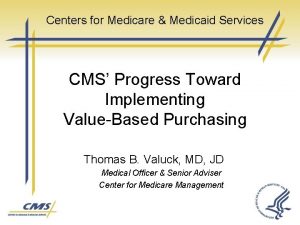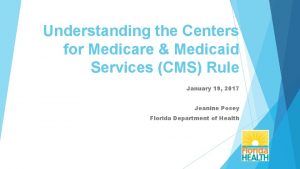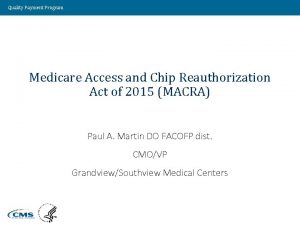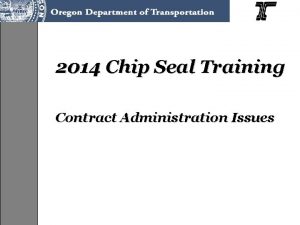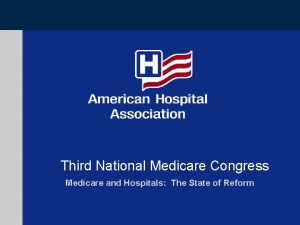Medicare Medicaid and CHIP CMS National Training Program












































- Slides: 44

Medicare, Medicaid, and CHIP CMS National Training Program April 2013

Session Topics 1. Introduction to Medicare 2. Medicaid and new eligibility group 3. Children’s Health Insurance Program (CHIP) 2

What Is Medicare? • Health insurance for three groups of people – 65 and older – Under 65 with certain disabilities – Any age with End-Stage Renal Disease (ESRD) • Administration – Centers for Medicare & Medicaid Services 3

The Four Parts of Medicare Usually Part A Hospital Insurance Part B Medical Insurance Part C Medicare Advantage Plans (like HMOs and PPOs) Part D Medicare Prescription Drug Coverage 4

Medicare Part A (Hospital Insurance) • Most people receive Part A premium-free – If you paid FICA taxes at least 10 years • If you paid FICA less than 10 years – Can pay a premium to get Part A – May have penalty if not bought when first eligible 5

Medicare Part A Covered Services Inpatient hospital stays Semi-private room, meals, general nursing, and other hospital services and supplies. Includes care in critical access hospitals and inpatient rehabilitation facilities. Inpatient mental health care in psychiatric hospital (lifetime 190 -day limit). Generally covers all drugs provided during an inpatient stay received as part of your treatment. Skilled nursing facility care Home health care services Semi-private room, meals, skilled nursing and rehabilitation services, and other services and supplies Hospice care Blood Can include part-time or intermittent skilled care, and physical therapy, speech-language pathology, a continuing need for occupational therapy, some health aide services, medical social services, and medical supplies For terminally ill and includes drugs, medical care, and support services from a Medicare-approved hospice In most cases, if you need blood as an inpatient, you won’t have to pay for it or replace it. 6

Paying for Inpatient Hospital Stays For Each Benefit Period in 2013 Days 1– 60 Days 61– 90 Days 91– 150 All days after 150 04/02/12 You Pay $1, 184 deductible $296 per day $592 per day (60 lifetime reserve days) All costs Understanding Medicare 7

Paying for Skilled Nursing Facility Care For Each Benefit Period in 2013 Days 1– 20 Days 21– 100 All days after 100 You Pay $0 $148 per day All costs 8

Medicare Part B Coverage Doctors’ services • Services that are medically necessary (includes outpatient and some doctor services you get when you’re a hospital inpatient) or covered preventive services • Except for certain preventive services, you pay 20% of the Medicare-approved amount (if the doctor accepts assignment), and the Part B deductible applies Outpatient • For approved procedures (e. g. , X-rays, a cast, or medical and stitches) surgical • You pay the doctor 20% of the Medicare-approved services and amount for the doctor’s services if the doctor supplies accepts assignment. You also pay the hospital a copayment for each service. The Part B deductible applies. 9

Medicare Part B Coverage Home health • Medically necessary part-time or intermittent care services skilled nursing care, physical therapy, speechlanguage pathology services, occupational therapy, part-time or intermittent home health aide services, medical social services, and medical supplies. Durable medical equipment and an osteoporosis drug are also covered under Part B. • You pay nothing for covered services. 10

Medicare Part B Coverage Durable medical equipment Other (including, but not limited to) • Items such as oxygen equipment and supplies, wheelchairs, walkers, and hospital beds for use in the home. Some items must be rented. • You pay 20% of the Medicare-approved amount, and the Part B deductible applies. • Medically necessary medical services and supplies, such as clinical laboratory services, diabetes supplies, kidney dialysis services and supplies, mental health care, limited outpatient prescription drugs, diagnostic X-rays, MRIs, CT scans, and EKGs, transplants and other services are covered. • Costs vary. 11

Part B Covered Preventive Services • “Welcome to Medicare” exam • Yearly “Wellness” exam • Abdominal aortic aneurysm screening* • Alcohol misuse screening • Bone mass measurement • Cardiovascular disease screenings • Colorectal cancer screenings • Depression screening • Diabetes screenings • Flu shots • • • Glaucoma tests Hepatitis B shots HIV screening Mammograms (screening) Obesity screening Pap test/pelvic exam/clinical breast exam Prostate cancer screening Pneumococcal pneumonia shots Smoking cessation STI screening *When referred during Welcome to Medicare physical exam 12

When Can I Enroll in Part B Enrollment Period Initial Enrollment Period (IEP) When 7 -month period surrounding your birthday month General Enrollment Period (GEP) January 1–March 31 each year Effective July 1 Ø 10% penalty every 12 -month period if eligible but did not enroll Special Enrollment Period (SEP) 8 -month period beginning the month after you retire or lose employer based coverage, whichever comes first

Paying for Part B Services • In original Medicare you pay – Yearly deductible of $140 in 2012 – 20% coinsurance for most services • Some programs may help pay these costs 14

Monthly Part B Premium If your yearly income in 2011 was You pay File individual tax return File joint tax return $85, 000 or less $85, 001–$107, 000 $107, 001–$160, 000 $160, 001–$214, 000 above $214, 000 $170, 000 or less $170, 001–$214, 000 $214, 001–$320, 000 $320, 001–$428, 000 above $428, 000 $104. 90 $146. 90 $209. 80 $272. 70 $335. 70 15

Medigap Policies • Medigap (Medicare Supplement Insurance) policies – Private health insurance for individuals – Sold by private insurance companies – Supplement original Medicare coverage – Follow federal/state laws that protect you 16

Medigap • Costs vary by plan, company, and location • Medigap insurance companies can only sell a “standardized” Medigap policy • Identified in most states by letters • MA, MN, and WI standardize their plans differently • Does not work with Medicare Advantage • No networks except with a Medicare SELECT policy • You pay a monthly premium 17

Medigap Benefits Medigap Plans A B C D F* G Part A coinsurance up to an addition 365 days K** L** M N Part B coinsurance 50% 75% Blood 50% 75% Hospice care coinsurance 50% 75% Skilled nursing coinsurance Part A deductible Part B excess charges Foreign travel emergency (up to plan limits) 50% *Plan F has a high-deductible plan Out-of-pocket limit** *** Plan N pays 100% Part B coinsurance with copay ** Plans K and L have out-of-pocket limits of $4, 660 and $2, 330 respectively $4, 660 $2, 330 up to $20/$50 for emergency room visits not resulting in inpatient 18

Medicare Advantage (MA) Plans Health plan options approved by Medicare Also called Medicare Part C Run by private companies Medicare pays amount for each member’s care • Another way to get Medicare coverage • Part of the Medicare program • May have to use network doctors or hospitals • • 19

Types of Medicare Advantage Plans • Medicare Advantage Plans include – Health Maintenance Organization (HMO) – Preferred Provider Organization (PPO) – Private Fee-for-Service (PFFS) – Special Needs Plan (SNP) – HMO Point-of-Service Plan (HMOPOS) – Medicare Medical Savings Account (MSA) • Not all types of plans are available in all areas 20

Medicare Prescription Drug Coverage • Also called Medicare Part D or PDPs • Available for all people with Medicare • Provided through – Medicare Prescription Drug Plans – Medicare Advantage Plans – Other Medicare Plans • Must include range of drugs in each category 21

Extra Help with Drug Plan Costs • Help for people with limited income and resources • Social Security or state makes determination • Some groups automatically qualify – People with Medicare and Medicaid – Supplemental Security Income (SSI) only – Medicare Savings Programs • Everyone else must apply 22

Income and Resource Limits • Income • Below 150% federal poverty level 2012 amounts q q q $1, 396. 25 per month for an individual* or $1, 891. 25 per month for a married couple* Based on family size • Resources 2012 amounts • Up to $13, 010 (individual) • Up to $26, 120 (married couple) q Resources include money in a checking or savings account, stocks, and bonds. q Resources don’t include your home, car, burial plot, burial expenses up to your state’s limit, furniture, or other household items, wedding rings or family heirlooms. *Higher amounts for Alaska and Hawaii 23

Improved Coverage in the Coverage Gap What You Pay for Brand Name What You Pay for Generic Year Drugs in the Coverage Gap 2012 2013 2014 2015 2016 2017 2018 2019 2020 50% 47. 5% 45% 40% 35% 30% 25% 86% 79% 72% 65% 58% 51% 44% 37% 25% Note: Dispensing fees are not discounted. 24

Medicaid and New Eligibility Group • What is Medicaid – Medicare Savings Programs • New Eligibility Group 25

Medicaid • Federal-state health insurance program – For people with limited income and resources – Certain people with disabilities • • Most costs covered for Medicare/Medicaid Eligibility determined by state Application processes and benefits vary Office names vary 26

Medicaid Waivers • Allow states to test alternative delivery of care – Certain federal laws “waived” • Types of waivers – Section 1915(b) Managed Care Waiver – Section 1915(c) Home and Community-Based Services Waiver – Section 1115 Demonstration Waiver – Concurrent Section 1915(b) and 1915(c) Waivers 27

Medicare Savings Programs • Help from Medicaid paying Medicare costs – For people with limited income and resources – Programs include • • Qualified Medicare Beneficiary (QMB) Specified Low-income Medicare Beneficiary (SLMB) Qualifying Individual (QI) Qualified Disabled & working Individuals (QDWI) 28

Medicare Savings Program Qualified Medicare Beneficiary (QMB) Eligibility § Eligible for Medicare Part A § Income not exceeding 100% FPL § Resources not exceeding the full LIS subsidy resource level – For 2012: $6, 940 individual/$10, 410 married couple living together with no other dependents § Effective the first of the month after QMB eligibility is determined § Eligibility cannot be retroactive Helps Pay Your Part A and Part B premiums, deductibles, co-insurance, and copays Specified § Eligible for Medicare Part A Part B Low-income § Income at least 100%, but not exceeding 120% of FPL premium Medicare § Resources not exceeding the full LIS subsidy resource Beneficiary level (SLMB) – For 2012 $6, 940 individual/$10, 410 married couple living together with no other dependents § Eligibility begins immediately and can be retroactive up to three months 29

Medicare Savings Program Qualified Individual (QI) Eligibility Helps Pay Your § Eligible for Medicare Part A Part B § Income at least 120% but does not exceed 135% FPL premium § Resources not exceeding the full LIS subsidy resource level – For 2012 $6, 940 for an individual/$10, 410 married couple living together with no other dependents § Eligibility begins immediately and can be retroactive up to three months Qualified § Entitled to Medicare Part A because of a loss of Disabled and disability-based Part A due to earnings exceeding Working Substantial Gainful Activity (SGA) Individual § Income not higher than 200% FPL (QDWI) § Resources not exceeding twice maximum for SSI – For 2012: $4, 000 for an individual/$6, 000 married couple living together with no other dependents § Cannot be otherwise eligible for Medicaid Part A premium 30

Medicaid Eligibility in 2014 • Extends and simplifies Medicaid eligibility • Will replace categorical “groups” – Eligibility for all individuals • Under age 65 • At or below 133% FPL • Medicaid and CHIP simplification – Coordination with the Health Insurance Marketplace (Exchanges) 31

New Eligibility Group • Fills the gaps in existing Medicaid eligibility – Not mandatory – States had option to begin covering April 1, 2010 – Full implementation in January 2014 • Includes individuals – – – With income below 133% FPL Under age 65 Not pregnant Not entitled to or enrolled in Medicare Part A Not enrolled under Medicare Part B Not in any other mandatory group 32

New Eligibility Group • Straightforward structure of four major eligibility groups – Children – Pregnant women – Parents and caretaker relatives – The new adult group • Simplifies Medicaid and CHIP eligibility and enrollment • Ensures a seamless system of coverage 33

Simplifying Medicaid and CHIP • Move to MAGI; replaces complex rules in place today • Following state lead, modernizes eligibility verification rules to rely primarily on electronic data • The federal government will perform some of the data matches for states, relieving administrative burden • Renewals every 12 months – No face-to-face interview for MAGI-based enrollees at application or renewal – If eligibility can be renewed based on available data, no return form is needed 34

Coordination: A Seamless System of Coverage • Single, streamlined application for all insurance affordability programs • Coordinated policies across Medicaid, CHIP, and the Marketplace (Exchanges) • New website that provides program information and facilitates enrollment in all insurance affordability programs • New standards and guidelines for ensuring a coordinated, accurate, and timely process – Performing eligibility determinations – Transferring information to other insurance affordability programs 35

Children’s Health Insurance Program (CHIP) • What is it? • Who is eligible? 36

Overview of CHIP • • • Children’s Health Insurance Program (CHIP) Title XXI of the Social Security Act Part of the Balanced Budget Act of 1997 Covers America’s uninsured children Joint federal and state financing – Federal Medical Assistance Percentages (FMAP) • Administered by each state • States have option to design program 37

CHIPRA • Children’s Health Insurance Program Reauthorization Act of 2009 • Also known as PL 111 -3 • Reauthorized CHIP effective February 4, 2009 38

CHIP Program • Provides health insurance for children – Up to age 19 and those not already insured – Must meet other requirements • A federal/state partnership • States set own guidelines within federal rules • The way CHIP is funded – It’s not an entitlement program 39

What Has Not Changed 04/02/2012 Medicaid and the Children's Health Insurance Program 40

Who Is Eligible? • Uninsured children and pregnant women – Family income too high for Medicaid • CHIPRA makes it easier to obtain and access CHIP health care for – Uninsured children with higher income – Uninsured low income pregnant women – Children born to women receiving pregnancyrelated assistance • Get automatic enrollment in Medicaid or CHIP 41

Eligibility and Enrollment Processes • States can use public “express lane agencies” – For initial eligibility and redetermination • Allows for auto enrollment • State required to – Verify ineligibility – Document citizenship – Compute and report payment reviews 42

Citizenship Requirement • States have options – State may lift five-year ban on covering legal immigrants – Citizenship documentation requirements apply • Tribal membership and enrollment documents satisfy requirements • Changes retroactive to 2006 43

Introduction to Medicare Resource Guide Resources Medicare Products Centers for Medicare & Medicaid Services (CMS) 1 -800 -MEDICARE (1 -800 -633 -4227) (TTY 1 -877 -486 -2048) www. medicare. gov State Health Insurance Assistance Programs (SHIPs)* Medicare & You Handbook CMS Product No. 10050 *For telephone numbers, call CMS: 1 -800 -MEDICARE (1 -800 -633 -4227) 1 -877 -486 -2048 for TTY users Your Medicare Benefits CMS Product No. 10116 www. CMS. gov www. medicare. gov/caregivers Social Security 1‑ 800‑ 772‑ 1213 TTY 1‑ 800‑ 325‑ 0778 www. socialsecurity. gov Railroad Retirement Board 1 -877 -772 -5772 www. rrb. gov www. Health. Care. gov www. pcip. gov www. Benefits. gov www. Insurekidsnow. gov Affordable Care Act http: //www. healthcare. gov/law/full/i ndex. html Choosing a Medigap Policy: A Guide to Health Insurance for People with Medicare CMS Product No. 02110 To access these products View and order single copies at www. medicare. gov Order multiple copies (partners only) at productordering. cms. hhs. gov. You must register your organization. 44
 National medicare training program
National medicare training program Medicare medicaid and schip extension act of 2007
Medicare medicaid and schip extension act of 2007 Shiba rainbow chart
Shiba rainbow chart Khmer rouge apush
Khmer rouge apush Methylation & chip-on-chip microarray platform
Methylation & chip-on-chip microarray platform Medicare parts c and d general compliance training answers
Medicare parts c and d general compliance training answers National association of state medicaid directors
National association of state medicaid directors Medicare training 101
Medicare training 101 Downstream entity examples
Downstream entity examples Humana medicare advantage certification
Humana medicare advantage certification Melanie watterberg
Melanie watterberg Medicare leads free
Medicare leads free Medical transportation management rhode island
Medical transportation management rhode island Ny medicaid ehr incentive program
Ny medicaid ehr incentive program Cms td program
Cms td program Cbc cms file generator program
Cbc cms file generator program Medicare part c d
Medicare part c d Medicare improvements for patients and providers act
Medicare improvements for patients and providers act National unification and the national state
National unification and the national state Ncsct training
Ncsct training Medicare phonetic alphabet
Medicare phonetic alphabet Cigna surround
Cigna surround Trailblazer health enterprises
Trailblazer health enterprises Refeeding syndrome electrolytes
Refeeding syndrome electrolytes Us medicare card
Us medicare card Planneca
Planneca Molina medicare options plus
Molina medicare options plus New medicare card poster
New medicare card poster Mbi lookup tool ngs
Mbi lookup tool ngs How to win a medicare appeal for skilled nursing
How to win a medicare appeal for skilled nursing Medicare advantage risk adjustment 101
Medicare advantage risk adjustment 101 Medicare oncology care model
Medicare oncology care model Csi office on aging
Csi office on aging Medicare preventive services quick reference
Medicare preventive services quick reference Tammy flanagan medicare
Tammy flanagan medicare Medicare advantag
Medicare advantag Medicare part d covers
Medicare part d covers Medicare assistant
Medicare assistant Acno plasma shower
Acno plasma shower Knee mri medicare
Knee mri medicare Medicare carve out
Medicare carve out Medicare health outcomes survey
Medicare health outcomes survey Medicare jurisdiction k
Medicare jurisdiction k We speak medicare
We speak medicare Obesity ibt
Obesity ibt
